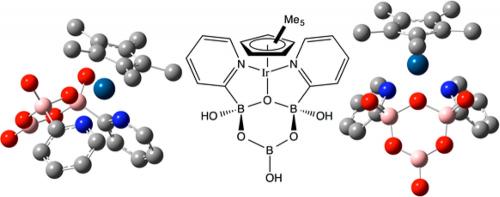
In the search for pre-cursors to homogeneous, periodate-driven oxygen evolution catalytsts, postdoc Aaron Bloomfield and members of the Crabtree lab, in collaboration with the group of Victor Batista, have synthesized a new iridium precursor complex with a unique mixed organic-inorganic ligand to stabilize the resultant catalyst during oxygen evolution. Their results have just been published in Inorganic Chemistry. The dianionic, tridentate ligand prevents the formation of iridium oxide nanoparticles during the initial and most active stages of water oxidation.
Organometallic iridium complex containing a dianionic, tridentate, mixed organic–inorganic ligand
Aaron J. Bloomfield, Adam J. Matula, Brandon Q. Mercado, Victor S. Batista, Robert H. Crabtree
DOI: 10.1021/acs.inorgchem.6b01218
Abstract:
A pentamethylcyclopentadienyl-iridium complex containing a tricyclic, dianionic, tridentate, scorpionate (facial binding), mixed organic-inorganic ligand was synthesized and characterized by single-crystal X-ray crystallography, as well as polynuclear NMR, UV-vis, and IR spectroscopies. The central cycle of the tridentate ligand consists of a modified boroxine in which two of the boron centers are tetrahedral, anionic borates. The complex is stable to hydrolysis in aqueous solution for >9 weeks at 25 0C but reacts with a 50 mM solution of sodium periodate within 12 s to form a periodate-driven oxygen evolution catalyst that has a turnover frequency of >15 s-1. However, the catalyst is almost completely deactivated within 5 min, achieving an average turnover number of ca. 2500 molecules of oxygen per atom of iridium. Nanoparticles were not observed on this time scale but did form within 4 h of catalyst activation under these experimental conditions. The parent complex was modeled using density functional theory, which accurately reflected the geometry of the complex and indicated significant interaction of iridium- and boracycle-centered orbitals.